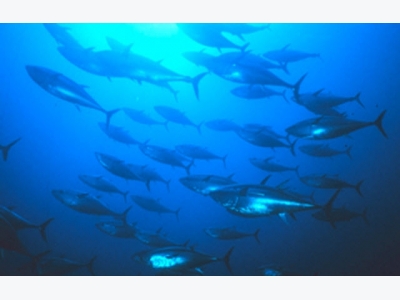Feds say Pacific bluefin tuna population overfished, but not endangered

U.S. officials issued a report earlier this week concluding that while Pacific bluefin tuna may have experienced some overfishing in recent years, the highly coveted species has not reached the point where it’s endangered.
A team of scientists from the National Marine Fisheries Service released its report on Monday after a nearly year-long investigation prompted by petitions from environmental groups seeking the protected status for the tuna.
It is considered a high-priced seafood delicacy, often served as sushi. In January, a Japanese businessman spent JPY 74.2 million (USD 636,000) for a 467-pound (212-kilogram) bluefin tuna at a Tsukiji fish market auction in Tokyo.
The tuna have spawning areas in the Sea of Japan and near Taiwan. However, the fish are known to migrate throughout the Pacific Ocean, including along the coasts of the United States, Mexico and Australia. Those who sought the endangered status claim many bluefins are caught before they can return to their spawning areas and grow the population.
“This disappointing decision makes it even more important for consumers and restaurateurs to boycott bluefin until the species recovers,” said Catherine Kilduff, an attorney with the Center for Biological Diversity.
However, in a Monday press conference, officials with NMFS and the National Oceanic and Atmospheric Administration cited a 2014 assessment indicating there were 1.6 million bluefins, including 140,000 of reproductive age. By comparison, a 2013 assessment of the North Pacific white shark indicated just 3,000 of its kind.
Environmental groups claim the Pacific bluefin population represents a 97 percent loss from its historical high. Federal officials pushed back on that claim, citing historical data that indicates the current population is about 25 percent of the population from the 1950s.
That doesn’t mean federal officials are thrilled with current numbers for the bluefin, but that alone did not warrant labeling the species as endangered. Dr. Matthew Craig, who chaired the review team, said modeling projections indicate either an increase or stability in the bluefin population in the years ahead.
“That’s a really promising sign that things are going well,” said Craig, who added the current population mirrors the numbers seen more than 30 years ago. The bluefin population grew over the next couple decades, he said.
The next assessment for Pacific bluefin tuna will occur next year.
Related news
 UK tops importers of Vietnam’s prawn in EU in 2016
UK tops importers of Vietnam’s prawn in EU in 2016 The United Kingdom was the largest importer of Vietnam’s prawns in the European Union (EU) in 2016
 India’s Telangana state builds fish markets, backs subsidies for sale of fish fingerlings
India’s Telangana state builds fish markets, backs subsidies for sale of fish fingerlings To provide local fisherman with a platform to sell their produce, India’s Telangana state will create 40 new fish markets in districts across the region.
 Prices dropping for Norwegian farmed salmon
Prices dropping for Norwegian farmed salmon The price of salmon farmed in Norway is expected to drop next week to between NOK 55 and 56 (USD 2.48 to USD 2.53, EUR 2.11 to EUR 2.15) per kilo for deliveries